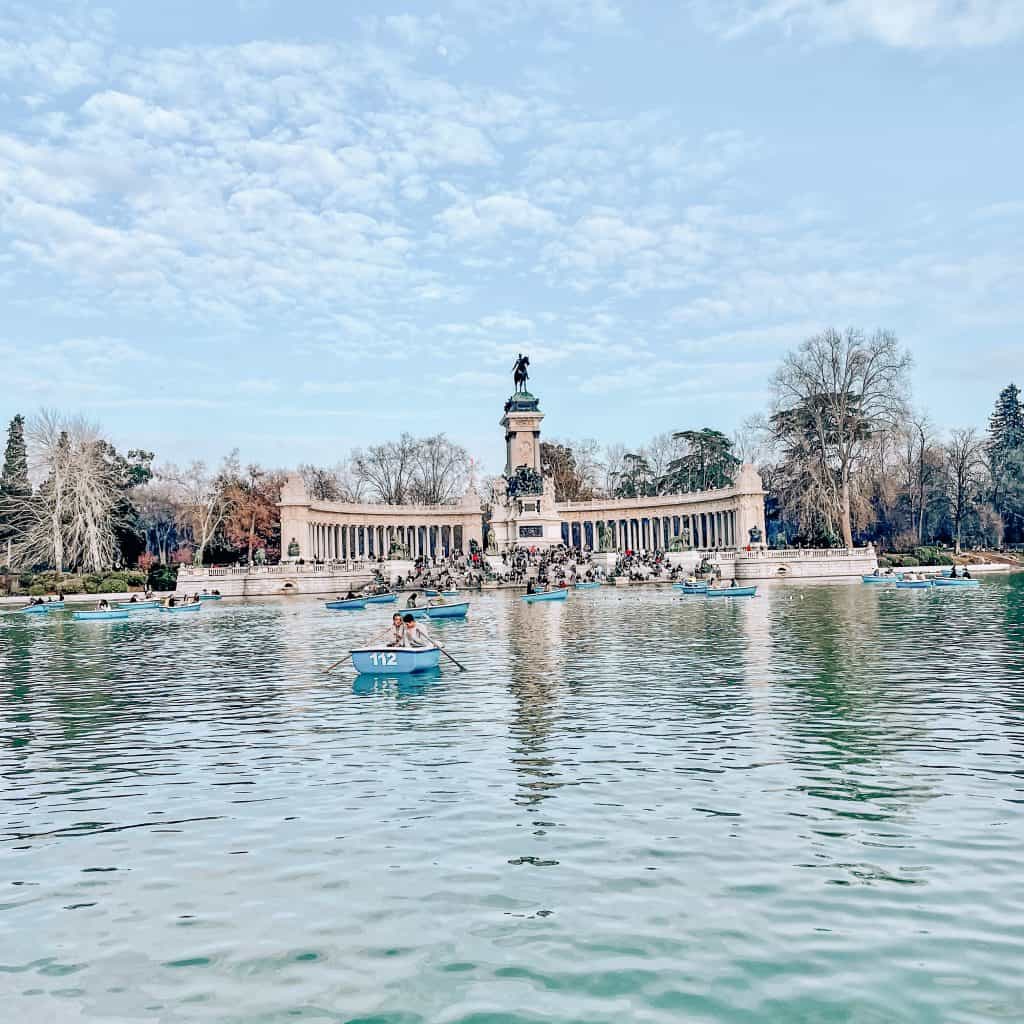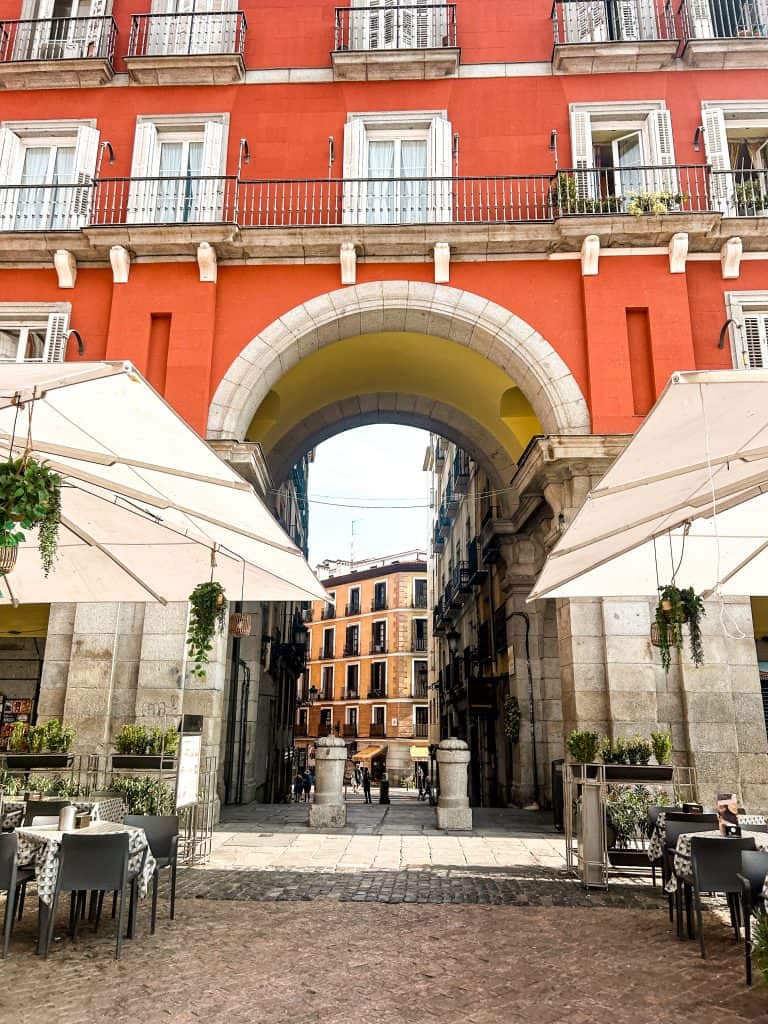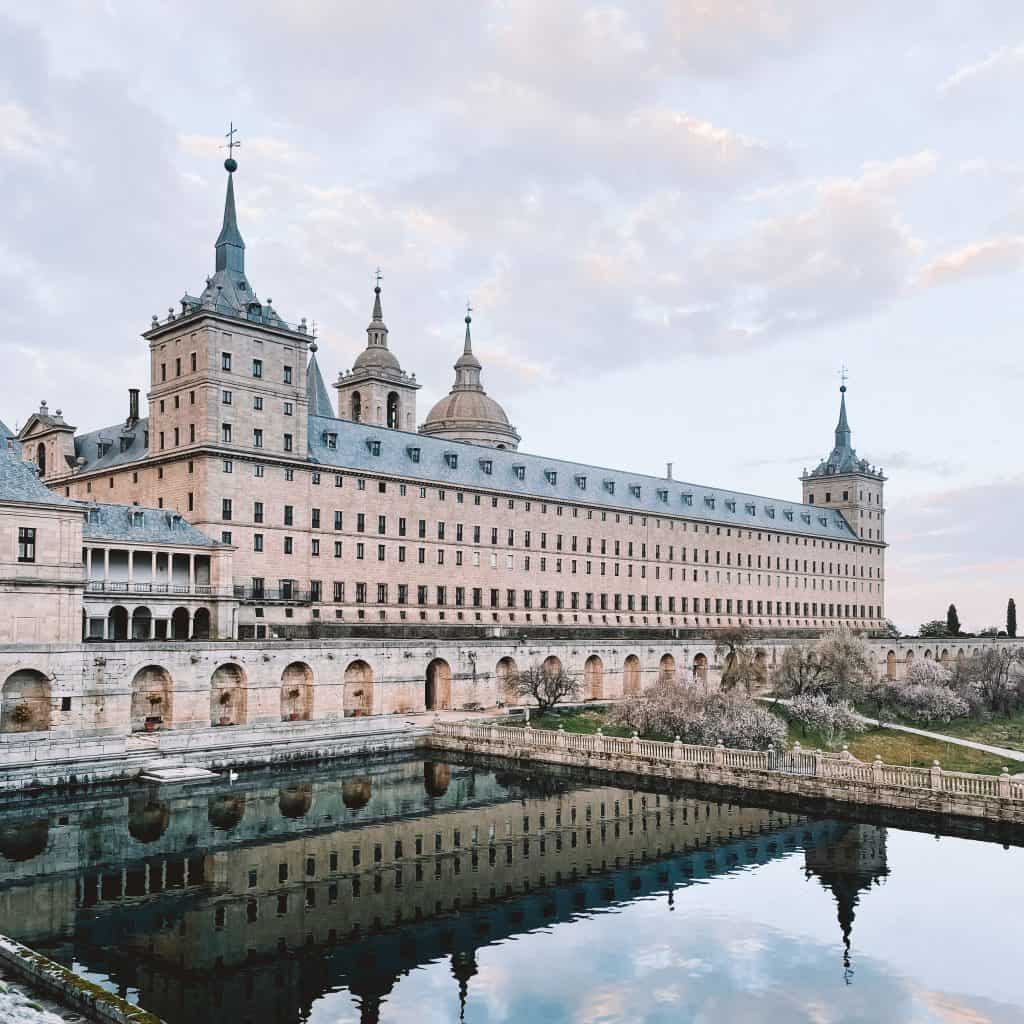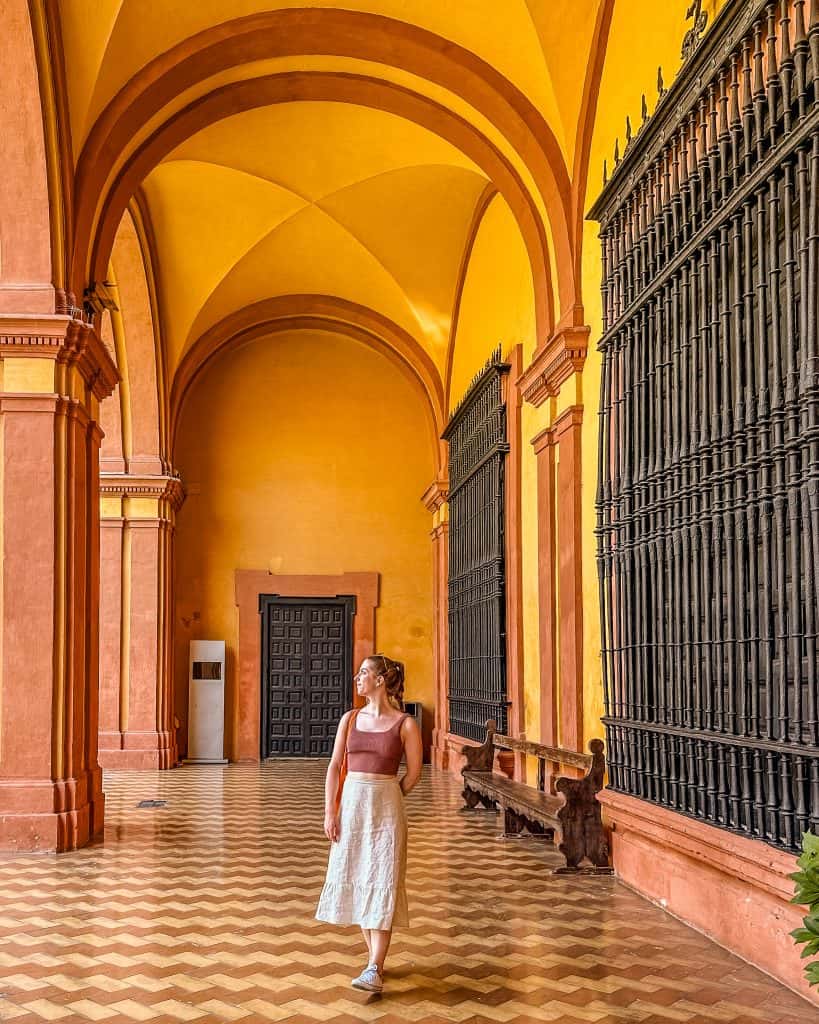Guide to Living in Spain: Pros, Cons & What to Expect (2025)

Planning on living in Spain? I’ve got you covered!
Moving to Spain is a dream for so many people—and it’s easy to see why! The country is brimming with vibrant culture, jaw-dropping architecture, and a lifestyle that’s all about slowing down and savoring the moment.
During my five months living in Madrid while studying abroad, I experienced firsthand the magic that makes living in Spain such an incredible experience. It was one of the best chapters of my life, and I know I’ll live there again someday.
In this guide, I’ll share the good, the not-so-good, and everything in between based on my time living in Madrid and traveling extensively to cities like Barcelona, Seville, Valencia, Sitges, and more!
Living In Spain
From the sunny plazas and incredible tapas to the welcoming people and laid-back vibe, Spain has a way of capturing your heart and never letting go.
But, as with any place, it’s not all sunshine and siestas. Living in Spain comes with its unique quirks and challenges.
Whether you’re considering a move for work, study, or simply an adventure, understanding what to expect will make your transition much smoother.
Life in Spain is everything you’d imagine and then some! Think sunny afternoons in open-air cafés, lively markets bursting with fresh produce, and streets filled with history and charm.
The Spanish lifestyle revolves around enjoying life to the fullest, with a focus on community, food, and leisure. It’s no wonder people fall in love with this country so easily.

One of the first things you’ll notice is the slower pace of life. This was a major culture shock for me in the best way!
Spaniards take their time, whether it’s savoring a meal, closing up shop for a mid-afternoon siesta, or simply enjoying a long stroll through the park.
This might feel like a big shift if you’re used to the hustle of cities like New York, but it’s a refreshing change once you embrace it.
Spain is also incredibly diverse. Each region has its own culture, cuisine, and even language. From the artistic flair of Barcelona to the Moorish influence in Seville, there’s so much to explore and experience.
Whether you’re drawn to the buzz of big cities, the charm of small towns, or the serenity of coastal living, Spain truly has something for everyone.
Pros Of Living In Spain
1. Affordable Cost Of Living
Spain is surprisingly budget-friendly compared to many other Western European countries. Renting an apartment, dining out, and enjoying leisure activities won’t break the bank, even in major cities like Madrid or Barcelona.
This affordability makes living in Spain much easier, especially for students or those on a budget.
For example:
☑️ A meal at a local restaurant can cost as little as €10–€15. This makes it easier to fully enjoy life without constantly worrying about your budget.
Pro Tip: Many tapas bars offer free tapas with your drink order. When in doubt, opt for a local beer or wine and enjoy the extra snack—it’s a great way to sample the local flavors without breaking your budget.
☑️ A monthly public transport pass is incredibly affordable— €20 for those under 26 and around €50 for everyone else. You can also purchase an annual card for a larger discount.

I stayed in an apartment designed for student housing through “Mi Casa Inn” in the Atocha Río neighborhood. My rent was included in my study abroad fees, so I didn’t factor it into my day-to-day expenses.
However, if you were to pay out-of-pocket, it would cost around €900 per month.
Without the support of a program, expect to pay anywhere between €500 and €1,400 for an apartment, depending on its size and location.

Uber is also affordable in most places in Spain. I typically spent between €6-12 on rides in Madrid. Coming from Michigan and now living in New York City, the low Uber costs in Spain are a pleasant surprise.
Most activities in Madrid are accessible too. For example:
✅ Going out to eat was a regular part of my routine.
✅ Clubs typically charge €15–€25 for entry, which usually includes two drinks.
✅ Museums and guided tours are also affordable, making it easy to enjoy the culture without worrying about your budget.

2. Endless Things To Do
Whether you’re an art lover, history buff, or outdoor enthusiast, Spain will keep you endlessly entertained.
Madrid is home to world-renowned museums like the Prado and the Reina Sofía, while Barcelona showcases Gaudí’s architectural masterpieces, such as the Sagrada Família.
Looking to escape to nature? Spain’s beaches, mountains, and national parks are breathtakingly beautiful.
Don’t forget the countless festivals—La Tomatina, Las Fallas, and Semana Santa, to name just a few—that immerse you in Spanish culture.
While living in Madrid, I frequented many museums, admired the beauty of the Royal Palace, discovered stunning sunset spots, and dove into the unforgettable nightlife scene.
I also loved exploring “El Rastro” (a local flea market), strolling through Plaza Mayor, relaxing at Casa de Campo (a large park), shopping in Malasaña and along Gran Vía, and visiting El Retiro, where you can row boats or ride bikes.

Madrid was my home base, but I also explored other parts of Spain on weekends and during separate trips:
✅ There are plenty of scenic hikes near Madrid that are easily accessible by bus. One of my favorites was a hike in Cercedilla—the views were absolutely stunning!

✅ A day trip from Madrid to Segovia, Toledo, or El Escorial is a must. While these smaller cities may not be ideal for long-term living, they are rich in history and brimming with charm.
✅ Barcelona is also easy to reach from Madrid by train. While Barcelona is another expansive city, its culture is distinct from Madrid.
I highly recommend visiting the Picasso Museum, marveling at Gaudí’s architecture, and spending time at the Boqueria Market off Las Ramblas to sample incredible food.
✅ Just 30 minutes from Barcelona lies the charming beach town of Sitges. I’ve visited many times, and it’s the perfect place for a beach weekend and a break from city life.
✅ Valencia and Seville are also fantastic destinations in Spain. Valencia combines modern attractions, like the City of Arts and Sciences, with historic gems such as the Mercado Central.
Seville highlights its rich Moorish heritage with landmarks like the Alcázar and the Giralda. Both cities are full of museums, charming restaurants, and historic churches waiting to be explored.
✅ For surfing enthusiasts, San Sebastián is the place to be. This vibrant city offers a unique blend of beautiful beaches and urban energy.
San Sebastián delivers a perfect mix of relaxation and adventure. Its young, laid-back vibe makes it an unforgettable destination.

Lastly, if nightlife is your priority, Madrid is unparalleled. People travel from around the world to experience its legendary club scene, and I can confirm it does not disappoint.
Barcelona’s nightlife is incredible, too, but in my opinion, Madrid stands out. From various music genres to a late-night culture, nights out are perfect for dancing with friends until sunrise.
3. Fantastic Weather
Let’s talk about the sunshine—Spain has plenty of it! One of the biggest perks of living in Spain is the mild winters and hot, sunny summers.
Madrid boasts sunny days almost year-round, while coastal areas like Valencia and Malaga enjoy Mediterranean breezes that make them even more appealing.
The good weather means you can spend more time outdoors, whether it’s sipping coffee on a terrace or taking a weekend trip to the beach.

Prior to living in Madrid, I was used to cold, dark Michigan winters, and spending the winter in Spain– where it rarely snows or rains– was a welcome change.
You will definitely need a jacket in the winter, but the weather won’t stop you from spending time outside or taking weekend trips to hike or go to the beach.
4. Excellent Public Transport
Getting around Spain is a breeze thanks to its exceptional public transport system. Madrid and Barcelona’s metro systems are extensive, efficient, and budget-friendly.
For traveling between cities, the AVE high-speed trains will get you from Madrid to Barcelona in under three hours.
Even smaller towns have reliable bus systems, so you’ll never feel stranded. The public transport across Spain is amongst the best in the world and makes it incredibly easy to travel across the country– without a car and on a budget.
It is simple for a foreigner to navigate and easy to get used to.
5. Warm and Welcoming People
The Spanish are known for their friendliness and warmth. Whether you’re chatting with your local barista or striking up a conversation in a tapas bar, you’ll find that people are generally open and eager to connect.
While building deep friendships might take time, the welcoming atmosphere makes it easy to feel at home.

I immediately felt welcome in Spain. I was intimidated to live here at first, but everyone I encountered– whether it be my professors, school staff, apartment staff, new friends, classmates, or otherwise– made me feel welcome immediately.
Even if I were to live in Spain again without going through a program, I would feel welcome. When my phone was stolen, so many people helped me, and it’s a true sign of the kindness you can experience while living in Spain.
Cons Of Living In Spain
1. Language Barrier
While many Spaniards speak some English, especially in larger cities, it’s far from universal. Learning Spanish is essential for navigating daily life, whether it’s grocery shopping or making doctor’s appointments.
The good news? Immersing yourself in the language is a fantastic way to grow personally and feel more connected to the culture.
When I arrived in Spain, I was eager to practice my Spanish and aimed to become fluent. However, I assumed that in cities as large as Madrid and Barcelona, many people would also speak English. I was surprised to find that this wasn’t the case.
In certain neighborhoods and at some restaurants, English is common, but learning enough Spanish to get by is invaluable—I encourage this no matter where you travel!

Practicing Spanish was an incredible opportunity, but it didn’t come naturally to me. Communicating and navigating the city in Spanish often left me exhausted.
I made my fair share of mistakes, including a few transportation errors (oops—it’s all part of the process). One memorable challenge was filing a police report in Spanish after my phone was stolen. It was difficult at the time, but now it’s a funny story.
Experiences like these taught me to approach living in Spain with an open mind and a willingness to make mistakes.
I’d recommend not overscheduling yourself; leaving time to rest is crucial for managing the mental strain of constant language practice.

While the language barrier was initially difficult, it became easier with time. Madrid, in particular, has a vibrant community of Erasmus students, study-abroad participants, and expats.
I made friends from all over the world, and since English was often our common language, I ended up speaking it quite a bit, too.
If you’re nervous about the language barrier, don’t be. Living in Spain will immerse you in the language, and you’ll pick up Spanish faster than you expect.
2. Late Nights and Sleep Schedule
Spanish schedules are famously nocturnal. Dinner often starts at 9 or 10 PM, and nights out can last until the early hours of the morning.
If you’re an early bird, adjusting to this lifestyle might take some effort, but it’s also part of the fun of living in Spain.
This schedule took me some getting used to as I’m naturally an early riser. However, it was fairly easy to adjust.
Given I knew I was only going to be in Spain for 5 months, I made the most of every minute and often stayed out very late only to go to class a few hours later. My sleep schedule was fairly non-existent!

I have absolutely no regrets and made the most of my time, but if I were to live in Spain again, I would prioritize sleep more and maintain a better sleep schedule. It is not a way to live sustainably.
If you’re planning on living in Spain for a longer time or have to commit more time to work or school, build a routine that prioritizes sleep and wellness– whether that aligns with the country’s late nights or not.
3. Lack Of Urgency
The relaxed pace of life in Spain is both a blessing and a challenge. While it’s great for reducing stress, it can be frustrating when things move slowly—whether you’re waiting for a repairman or tackling administrative tasks.
Patience is key!
As someone who struggles with impatience, I found this aspect of living in Spain particularly challenging.
Coming from a fast-paced lifestyle that embodied the hustle culture of the U.S.—complete with workaholic tendencies—adjusting to a slower rhythm was a significant shift.

But mindset is everything. I knew I was heading into a lighter workload and a more relaxed lifestyle, which I genuinely needed.
By embracing that reality early on, I adapted to the slower pace much more easily than I would have if I’d clung to my old habits.
My best advice? Embrace the present moment as much as possible and schedule fewer activities throughout the day. Giving yourself the freedom to slow down eliminates the need to rush and allows you to fully enjoy Spain’s laid-back lifestyle.
4. Pickpocketing and Theft
Unfortunately, theft is a common issue in tourist-heavy areas like Barcelona and Madrid, so staying vigilant and keeping your belongings secure is essential, especially in crowded places.
As a young woman, I generally felt very safe in Spain, but theft is a reality.
While sitting alone at a café in Madrid, my phone and several important cards were stolen. A few of my friends also had their phones stolen while at a club.

Thankfully, I was able to replace almost everything, and luckily, my passport wasn’t taken. Still, it was a shocking experience.
On the bright side, it forced me to learn how to navigate the city without Google Maps—a skill I’m now very proud of—and it’s a funny story in hindsight.
However, I hope this never happens to you, so I recommend always keeping your phone in your sight and bringing as little as possible when you go out at night.
Pro Tip: If you carry a backpack, keep it in front of you instead of on your back, don’t keep your phone in your pocket, and consider using an anti-theft bag/ wallet.
I’d bring backup cash, an extra credit card, and copies of your important documents. With a little extra vigilance, you’ll be just fine and can enjoy your time in Spain with peace of mind!

Best Places To Live
1. Madrid
The bustling capital is perfect for those who love vibrant city life. Madrid offers a mix of history, culture, and modern amenities, plus a fantastic food scene. It’s centrally located, making it easy to travel to other parts of Spain (an amazing perk!).
Whether you’re a young professional, a student, or a family, Madrid has something to offer everyone. I’m slightly biased because I spent the most time here, but I loved it!
2. Valencia
Valencia is a coastal gem that combines the perks of city living with the beauty of Mediterranean beaches.
Known for its futuristic architecture, fantastic food, and laid-back atmosphere, it’s an ideal spot for families and expats seeking a slower pace of life.
Valencia is perfect if you want a smaller Spanish town but still want things to do.
3. Barcelona
Barcelona is a dynamic and cosmopolitan city that truly has it all: stunning architecture, world-class cuisine, and beautiful Mediterranean beaches. It’s a haven for art and design lovers.
The vibrant neighborhoods, bustling markets, and lively nightlife ensure there’s always something exciting to explore.
Like Madrid, Barcelona is perfect if you love city life, but I’d recommend Barcelona over Madrid for those who want to be closer to the beach.
4. Seville
Seville is the heart of Andalusia, famous for its flamenco dancing, historic landmarks, and sunny weather.
It’s smaller than Madrid or Barcelona but offers plenty of charm and a more traditional Spanish lifestyle. It’s a great choice if you’re looking for affordability and culture.
I loved Seville, and it would be a great place to live if you’re looking for a slower pace. For me, Seville was perfect just to visit as the general crowd tends to be older, and the lifestyle is slower.
5. San Sebastián
San Sebastián, nestled along the northern coast of Spain, is a beautiful blend of stunning beaches, world-class dining, and vibrant culture. It’s a haven for food lovers and outdoor enthusiasts alike.
If you’re into surfing, the waves here offer an exciting challenge for all levels.
While it’s not as fast-paced as larger cities, San Sebastián has a youthful, laid-back vibe, making it perfect for those seeking a blend of adventure and relaxation.
San Sebastián is one of my absolute favorite spots in Spain, and I’m sure I’ll be back—if not spending an entire summer here at some point!

FAQs
How much money do I need to live comfortably in Spain?
Living comfortably in Spain typically costs €1,200–€1,800 per month for a single person, depending on the city and your lifestyle.
Can a US citizen live in Spain?
Yes, but you’ll need a visa or residency permit. Popular options include student visas, work visas, and the non-lucrative visa for retirees or remote workers.
Pro tip: plan far in advance if you think you’ll need a visa! It can take a while. Check out the U.S. Embassy in Spain for more information.
Is it cheaper to live in the US or Spain?
For most people, Spain is more affordable, particularly when it comes to housing, dining out, and healthcare. Having lived in Denver, Ann Arbor, and New York City, Spain is more affordable than all three and significantly more affordable than living in New York.
Is healthcare free in Spain?
Spain’s public healthcare system is heavily subsidized and offers excellent quality. Expats can access it by contributing to the system or purchasing private insurance.
Top Recommendations on What to Bring
✨ Here’s a short list of recommendations on what to bring if you move to Spain ✨
- A Travel Backpack or Day Bag – Great for carrying your essentials while exploring cities or hiking. I recommend this Patagonia backpack
- A small carry-on bag- this is perfect for weekend trips- make sure you get a smaller one that fits European airline guidelines. I recommend either of these two from Away and Cotopaxi.
- Anti-theft phone case– great for protecting your phone from theft. I wish I had this!
- Spanish App – It’s helpful to know some basic Spanish for day-to-day interactions.
- Medical Kit and Prescriptions – Bring any medications you might need and a small first-aid kit.
- Mobile Hotspot- If you need to study or work, I recommend checking out this brand
- An international credit card- this is great for avoiding foreign transaction fees. I recommend Capital One or Chase Sapphire Card
- Digital and physical copies of all important documents
- Cash- I’d recommend bringing around €500
- Adapter and Power Converter – Spain uses Type C and F plugs (230V), so be sure to bring the right adapter for your electronics.
Conclusion
Living in Spain is a life-changing experience that blends culture, beauty, and adventure. From the vibrant streets of Madrid to the sun-soaked beaches of Valencia, there’s so much to fall in love with.
While there are challenges—like learning the language and adjusting to a new rhythm—the rewards far outweigh them. I would highly recommend living in Spain to anyone!
If you’re dreaming of a life filled with sunshine, delicious food, and unforgettable moments, Spain is calling. Pack your bags, brush up on your Spanish, and get ready for the adventure of a lifetime!







